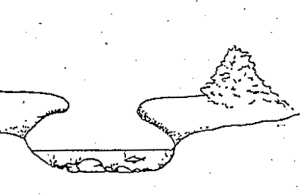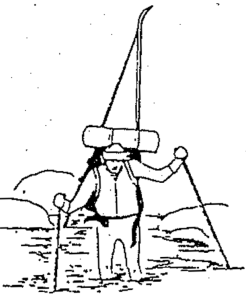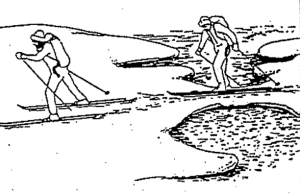River Crossings in Snow
Rivers

Fig 1A – Beward of snow banks collapsing at entry and exit points and iced over rivers

Fig 1B – Use stocks to aid balance during crossing
- Avoid if possible, particularly deep water
- Treat with extreme caution if you have to cross
- Beware extremely cold water conditions, snow banks collapsing at entry and exit points and iced over rivers (Fig. lA)
- Check entry and exit points are safe before entering water
- Remove skis before entering water. Carry by hand or preferably attached to pack
- Check pack shoulder straps loosened and waist strap are undone before entering water
- Use stocks to aid balance during crossing (Fig. IB)
- Always wear boots
Creeks
- Consider and check the possibility of ‘jumping’ small creeks
- If so, throw pack, skis and stocks onto other bank before jumping
- Beware skis sliding back into creek. Use a person on opposite bank to prevent this
Snow Bridges

Fig 1C – Only one person at a time to ski across bridge
- Check suitability and safeness of bridge before crossing on skis
- Choose a bridge whose width can be spanned by the length of skis
- If safe to cross release ski safety straps, take hands out of stock wrist straps, and undo rucksack waist band
- Only one person at a time to ski across bridge (Fig. 1C)
- Beware overhanging snow banks and possibility of bridge collapsing
- Beware danger of fallen person being swept under a snow bank or a snow tunnel